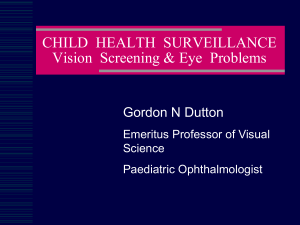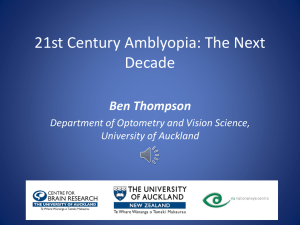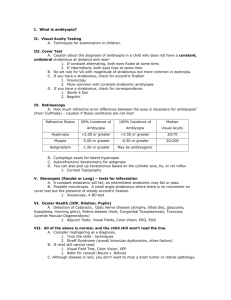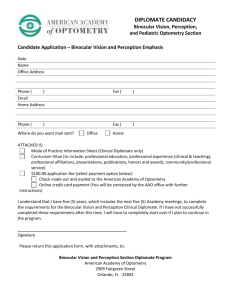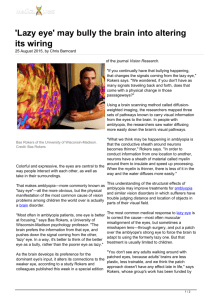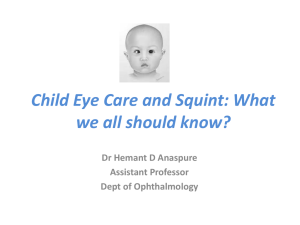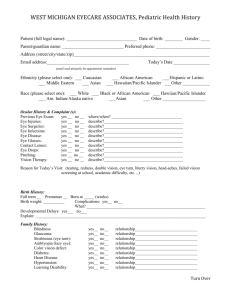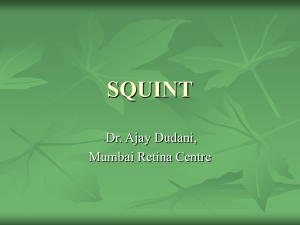Pictures
advertisement
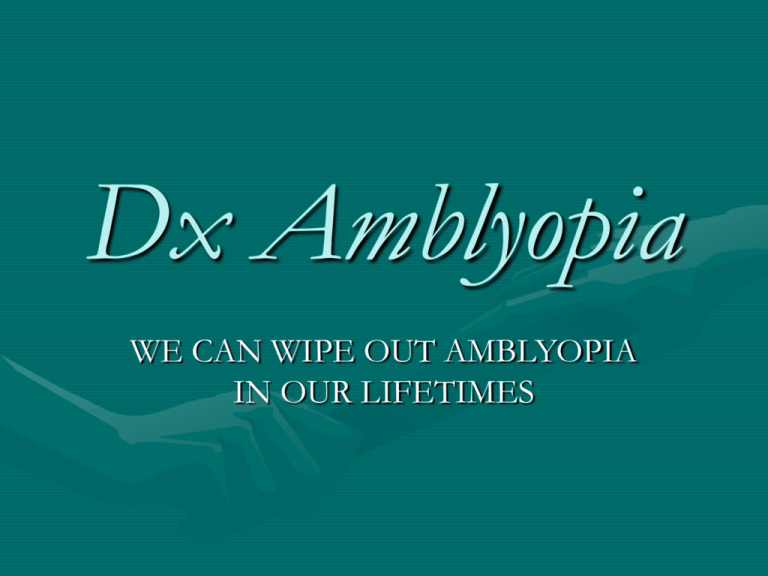
Dx Amblyopia
WE CAN WIPE OUT AMBLYOPIA
IN OUR LIFETIMES
OVERVIEW
• Amblyopia Characteristics/Therapy
– Most Clinico-Legal Problems for OD’s
•
•
•
•
•
•
Infantile Esotropia-A Case
The Infant Examination Sequence
Infantile Esotropia Characteristics
Infantile Esotropia Therapy
The Older Esotrope
Exotropia: “Congenital” & “Functional”
AMBLYOPIA
Caused by Anisometropia and
Strabismus and what most eye care
practitioners are interested in treating
Rule Out Pathology
Ocular and Neurologic Disease
Masquerading as Functional Vision
Disorders
• Amblyopia
• Strabismus
– Brain Tumors: Bitemporal Field Loss
– Vascular Accidents
– Ocular and/or Visual Pathway Diseases
Amblyopia
• Amblyopia: A Diagnosis of Exclusion.
Make sure there is no pathology first.
• Amblyopia may improve with vision
therapy even with pathology
• Always do visual fields of both eyes of
amblyopes (color and neutral density)
• Must have 1. Anisometropia, 2. Constant
Unilateral Strabismus, 3. ^ Bilateral RE,
4. Deprivation Hx
Bilateral Amblyopia-Careful
• Bilateral Retinal Schisis--X-Linked
• Electrodiagnostics
– ERG Electroretinogram
– VEP Visual Evoked Potential
– Pictures
•
•
•
•
X Rays
CT Scans
MRI’s
OCT
Amblyopia Differential Dx
• Block-Line-Letter VA s: Better with letters
– Contrast Typically not impacted in Amblyopia
•
•
•
•
Psychometric VA s: Sigmoid Curve
Neutral Density Filters: Devastates VA
Macular Integrity Tester: No Brush
Magnification: 2.5 Telescope really improves
VA beyond what is expected
• Color Vision: Normal
• Normal Amsler Grid and
Electrodiagnostics
Special Visual Acuity Charts
• Psychometric Chart
– Flom Chart C’s
– Wesson-Davidson Chart E’s
• Bailey-Lovie log MAR
– Relative = Separation
– High and Low Contrast
• Contrast Sensitivity
• LEA
• B-VAT
Amblyopia and VA
•
•
•
•
•
•
•
Acuity improves with isolated letters
First and last letter seen more often
Letters read out of order
Letters change as chart is viewed
Chart appears gray, dim or poor quality
Refraction: Better but I just cannot read it
LARGE JND’s
Amblyopia
• 2.5% of population
• A problem of binocularity
• Fixation--Binocularity
– Anisometropia
– Constant Unilateral Strabismus
Amblyopia Timelines
• Critical Period: Birth to 6 mo…Treat now…
Blind-Nystagmus
– Treat Pathology…Fixate with each eye
• Sensitive Period: 6 mo to 8 yr.… Treat…
Visually Impaired
• Susceptible Period: 8 to 18 yr.…Treat if
compliant…may return
• Residual Plasticity Period: 18 yr.> not likely
(Lee R. Adult Amblyope: JBO 12/99 pp115131)
Amblyopia is Developmental
& A BINOCULAR Dx
•
•
•
•
Not just a reduction in VA but in total vision
Poor Eye Movements
Poor Accommodation
Poor Spatio-Temporal Integration…Trouble
judging distances and lengths…Crowding
– Requires more than just patching
Clinical Classification of
Amblyopia
•
•
•
•
Organic (Organic)
Form Deprivation (Structural)
Strabismus (Spatial Conflict)
Refractive
– Isometropic and Anisometropic
• Psychogenic
– Voluntary (Malingering)
– Involuntary: Hysterical and Streff ’s Syndrome
Amblyopic Clinical Pearls
• Problems within 1st 6 months most
dangerous---Congenital Cataracts-Critical
– Early dense cataracts-a true critical intervention
• Late onset not as severe-Sensitive-Can be
amblyopic up to about 8 years
• Treatment at any time but less certain
outcomes-Requires a motivated patient
Streff ’s Bilateral Juvenile
Amblyopia
•
•
•
•
Refracts: -.5 to +1D…+ may help
VA Far: 20/25 to 20/400…Walk around +
VA Near: Worse than Far…^ c +
Habitual RD: 10 in or less/Peers…+ moves
RD out
• Dynamic Ret: Dull reflexes and increased lag…
+ improves reflexes
• Fixation: Unstable central… + ^ stability
Streff ’s Bilateral Juvenile
Amblyopia
•
•
•
•
•
•
Pursuit: Refixations… + improves
Pen in Cap: Misses… + improves
Yoked ^: Base preferred
Ball Catching: + improves timing
VO Star: Poor Centration… + improves
History: High achiever, females, around
puberty, at exam time, holidays and spring
Streff ’s Syndrome in Animals
Tx Amblyopia
Amblyopia Efficacy of VTx .1
Significance at 16+ for 4 lines
Birnbaum et al. JAAO May 77
60
50
40
Four lines
20/30
30
20
10
0
< 7yrs
7-10 yrs
11-15 yrs
16+ yrs
Congenital esotropia vs.
amblyopia: surgery or none
Helveston, EM. Origins of congential esotropia. J Ped Ophthalmol
Strab 1993;30:215-232
45
40
35
30
25
Amblyopia
20
15
10
5
0
No Surgery
Surgery
Surgery
Treatment of Amblyopia
• Isometropic: >-5D eventual full Rx but in
steps…. Consider underminus…>+ 2D Temper
Rx by age, amount, in steps, keep
symmetrical…Think in terms of keeping 2D of
hyperopia uncorrected... Cylinder >1.25
Temper Rx as with +…symmetrical and
low…always trial frame…PROBE LENS
TESTING
Amblyopia
• Anisometropia: >-2D or +1D consider CL
(depending on the age and responses) …
• Eventual full Rx may be much more balanced…
• MOST ANSIO AMBLYOPIA from + > 1
• Keep symmetrical and spherical equivalents
• Keep Rxs Small
and Simple
Occlusion
• Full Time Direct Occlusion
– 1 day for each year of life and no patch the other
day for the anisometropic amblyope
– For the strabismic amblyope indirectly patch the
other eye for one day
• Partial Occlusion
– Bi-Nasal Occlusion
– Patch for hours rather than days
Treatment Modalities for Amblyopia
•
•
•
•
Patching verses Penalization
Big advantage of Penalization-it can be done
Binocularity is not destroyed
Penalization
–
–
–
–
–
Bangerter Foils
Fingernail Polish
Scotch Tape
Extra Plus
Meds
Penalization
•
•
•
•
•
•
•
•
•
Foils
Colored Filters (Mono in Binocular Field)
Wesson Method
Extra Plus
Clear Finger Nail Paint
Cycloplegia
Bi-Nasal Occlusion
Bi-Temporal Occlusion
Atropine
Rxs for the older Amblyope and
Esotrope
•
•
•
•
Always try to balance Rx
Use minimal Rx to plateau VA
Use minimal Rx to plateau Angle of turn
Hold off Rxing lenses until some VT has been
attempted (weeks)
• Plan to titrate UP + on esotropes and
anisometropes
Contact Lenses and Amblyopia
• Knapp’s Law: Predicts image size based upon
length of the eye--spectacles more appropriate
• Think CL even with Knapp’s Law
– More likely to wear than “odd” glasses
– better image quality
– No prismatic or Centration problems
Amblyopia Therapy: Press
• Refractive Amblyopia
–
–
–
–
–
–
–
Normally responds quicker than strabismus
Passive Suppression
Binocular integration present
Less occlusion time needed
Loss of resolution - little spatial distortion
Knows where and how far the target is
Like looking in smoked glass or cellophane
Amblyopia Therapy
• Strabismic Amblyopia
–
–
–
–
–
Loss of resolution and spatial confusion
Takes more time
Must develop central fixation first
Active suppression
Poor performance
Summarized Early Phases -Tx
• Rx
• Monocular activities
–
–
–
–
–
Patching/Penalization
Accommodation
Ocular Motility
Form Recognition (Modified Updegrave)
Perceptual Discrimination (Size, Shape, Feely Meely,
etc)
Later Phases Tx Amblyopia
• Monocular Fixation in a Binocular Field
• Biocular Therapy
• Binocular Therapy
• Intersensory Integration
Monocular Therapy
• Press Recommends 3 Levels
– Gross Motor (Use Sparingly with Patching)
• Balance Board
• Walking Rail
– Oculomotor
– Accommodative
Monocular Therapy
• Oculomotor
–
–
–
–
–
–
–
–
–
Hart Chart saccades
Michigan tracking
Pointer in Straw
Monocular Prism Jumps
Geo Boards, Groffman tracing
AN Pointing
Line Counting
Perceptuomotor Pen
MIT
Monocular therapy
• Accommodative
–
–
–
–
–
Near Far Hart Charts
Free Space Push Up
Loose Lens Rock
Sequential Minus (JND’s)
Minus Lens and Marsden Ball
Mono Tx Perceptual Discrim
• Hidden Pictures
• Similarities and Differences
• Monocular Contour Interaction (Back off and read
letters/numbers)
• Random Count All of certain # or letters
(Michigan Tracking)
• Tachistoscope
• Form Tracing with Crowding -Kedzia Card
• Visual Search Sequential # find correct one
• Space Matching Distance to Chalkboard
Monocular Tx in Binocular
Field
• Anaglyphic TV Trainer (Projected Light)
• Sherman VT Playing Cards (1/2 Cards)
• Lens rock with single Vectogram VA
(corresponding to amblyopic eye)
– Quoits
– Clown/Spirangle
•
•
•
•
Wayne Fixator and Anaglyph
Anaglyphic Tracing
Haidinger Brush/MIT
Kedzia Cards
WHY DO VT ON AMBLYOPES: If
Patching gives good VA
• Krumholtz & FitzGerald. Efficacy of treatment modalities in refractive
amblyopia. J AOA 1999; 70: 399-404
• VA’s the same with Patching &full Rx or
Patching, full Rx&VT (2 line & 20 ArcSec)
• Both Patching and Patching VT group better
than Optical Correction alone
• ONLY VT GROUP HAD BETTER STEREO
Efficacy of Tx on Amblyopia
Krumholtz I, FitzGerald D. Efficacy of treatment modalities in refractive amblyopia J am Optom Assoc 1999; 70: 399-404
•
•
•
•
•
Compare (6 mo) Rx; Rx & Patch; Rx/VT N=78
2 Line and 20 sec increase; the criterion
Patch and VT have similar VA’s
VT shows significantly greater stereo
Conclusion:“Patching alone…improvement of
visual acuity, binocular performance is significantly
better when vision therapy is included in the
treatment regimen.”
FitzGerald: Amblyopia
Krumholtz I, FitzGerald D. Efficacy of treatment modalities in refractive
amblyopia. J Am Optom Assoc 1999;70:399-404
• Amblyopia from Refractive (Aniso)
• 2 lines & 20arcsec Improvement
• Tx
–
–
–
–
Do Nothing
Rx
Rx + Patch and Eye Hand
Rx + Patch and Eye Hand and VTx
• Retrospective
–
–
–
–
4 to 6 weeks after
2 to 4 months
6 months to 12 months
Note in all Tx: Some make dramatic improvement and some never move
• Patch and VTx are the Same for Amblyopia Tx
• Rx alone was not as effective
FitzGerald: Amblyopia VA &Stereo
Krumholtz I, FitzGerald D. Efficacy of treatment modalities in refractive
amblyopia. J Am Optom Assoc 1999;70:399-404 & S
• Optical Correction Alone 41% VA and 18%
Stereo
• Optical Correction and Patch 69% VA and 30%
Stereo
• Optical Correction; Patch and VTx 67% and
67%
FitzGerald: % Improvement
Refractive Amblyopia VA & Stereo
Krumholtz I, FitzGerald D. Efficacy of treatment modalities in refractive
amblyopia. J Am Optom Assoc 1999;70:399-404
70
60
50
40
Opt Cor
O C & Pat
OC, Pat VTx
30
20
10
0
Vis Acuity
Stereo
FitzGerald: Refractive Amblyopia
FitzGerald DE, Krumholtz I. Maintenance of improvement gains in
refractive amblyopia: a comparison of treatment modalities. Optometry
2002; 73: 153-9.
• Maintenance of Visual Acuity Gains over Time (From
1 to 2 years)
– Optical Correction 50%
– Optical Correction & Patching with Eye Hand Activities
60%
– Optical Correction & Patching with Eye Hand Activities and
Vision Therapy 100%
– 94% of those who maintained their VA’s maintained their
stereo
FitzGerald: Refractive Amblyopia
FitzGerald DE, Krumholtz I. Maintenance of improvement gains in
refractive amblyopia: a comparison of treatment modalities. Optometry
2002; 73: 153-9.
70
60
50
40
VA End
VA Held
30
20
10
0
OC
OC + Patch
OC,Pat, VT
Rx, Rx & Patch, Rx & VT
Krumholtz, FitzGerald 1999
70
60
50
40
Rx
Patch
VT
30
20
10
0
VA
Stereo
Maintenance of Gains Amblyopia
FitzGerald DE, Krumholtz I. Maintenance of improvement gains in refractive amblyopia:Optometry 2002; 73: 153-9.
• Records of 6 month study retrospectively at 1 to
2 years to see if gains are holding
• Holding Gains: N=23
– 50% with Rx
– 60% with Rx and Patching
– 100% with Rx and VT
• Oldest age held the best
VA Gains over Time for
Amblyopia (of those improved)
FitzGerald & Krumholtz 2002
100
90
80
70
60
50
40
30
20
10
0
Acuity
Rx
Occlusion
VT
VA Gains over Time for
Amblyopia (of those improved)
100
90
80
70
60
50
40
30
20
10
0
4-7 yr
7-10 yr
10-14 yr
Rx
Occlusion
VT
Amblyopia Tx and Compliance
(N=52) 3 mo Occlusion, previous failure in VA
improvement
Min’s…Amblyopia Moo & Ko.Proc 8 Japan-Korea Ophthal 1996
90
80
70
60
50
Child
Parent
40
30
20
10
0
Good
Fair
Bad
Summary: Amblyopia Tx
• Consider a modified Rx
• Consider some type of Patching/Penalization
• Central and Stable Fixation
– Central Fixation and Monocular Tx
• Equality between eyes
– Monocular Tx
• Monocular training in a binocular field
– Biocular Tx
• Suppression Therapy
– Biocular Tx
• Binocular integration
– Binocular Therapy
Infantile Esotropia
1st Case: Subjective
• 19 mo White Female
• Esotropia from 6 months
• Full Term Pregnancy: No problems with
pregnancy or birth-First Child
• Crawled at 6 months
• Walked at 10 months
• Threw tantrums and wanted things her way
when tired
1st Case: Subjective Continued
•
•
•
•
O-MD exam at 6 months
Healthy Eyes
Congenital Esotropia
Cycloplegic Rx dispensed (+2.25D sph OU) and
told to return in 6 months if not straight surgery
would be suggested
1st Case: Objective
•
•
•
•
•
•
•
Hyperactive Child
Present RX +2.25
Retinoscope at far +1.50
EOM’s full--OS less accurate
Head Movement
Uncoordinated Visual Motor Patterns (Body)
Eyes Healthy
1st Case: Assessment
Infantile Esotropia OS
with Hyperopia
1st Case: Plan
• Lenses
• Home Vision Therapy
– 2/week
• Later 1/week as a progress
examination
1st Case: Education
• No Guarantees
• Goal:
–Straight Eyes
–Diminish the Rx if Possible
1st Case: Initial Tx
• Periodic Patching (short periods of time-more
OD than OS)
• Movement Patterns of Head, Neck and Body
– Prone Neck Rotations
– Dry Land Swimming
– Crawling
• Bright Objects---Cross Patterning--VT depends on
motivation (Time at Task)
– Sleep Patterns
1st Case: Early Progress Exams
• 2 Weeks: Change Rx to +1.50 c +0.75 add
– Mother reports eyes are straighter
• 6 Weeks: Change +1.50D with Bi-Nasals
– Mother reports steady improvement of eyes-eyes are
straighter longer
• 9 Weeks: Change Rx to +0.75 c +0.75 Add
• 14 Week: Change Rx to +0.75 and released without binasal occlusion
1st Case: Later Progress Exams
• 1 month post release:
– Goes without lenses
– Eye does not turn normally
• Turns if tired or excited
• 3 months post release:
– Eyes seldom turn
– Seldom wears Rx
Long Term Follow Up
•
•
•
•
•
•
All State Basketball
All State Tennis
Full scholarship Southern Miss: Tennis
Real Estate Agent/Broker Gulfport/Wiggins
34 years of Age
Mother of 2
Strabismus
• Infantile-(within 6 months of age) 1-2% of
population
• Accommodative esotropia (typically 2 to 3
years) seen in 2-2.5% of population
• Most common-Pseudo-esotropia-• Provide Reassurance
• It is good to photo-document the Pseudo-esotropia
(Epicanthal Folds)
Tropia at Birth
Hainline etal Chap 15 Simon Early Visual Development
Normal and Abnormal Oxford Press 1993
70
60
50
40
Exotropia
Orthotropia
Esotropia
30
20
10
0
Nixon
Sondhi
Visual Acuities
•
•
•
•
•
•
•
Follows light and or bright object
Will reach for a candy bead
Optokinetic Nystagmus-Temporal/Nasal
Preferential Looking
Cereal Card
Broken Wheel
Lea
Pathologies
•
•
•
•
•
PUPILS and MOTILITIES
Around the eye
Anterior Segment
Posterior Segment
Ophthalmoscopy should always be last!
Refractive Error
•
•
•
•
•
•
Bruckner (Also Alignment)
Photorefraction
Mohindra’s Retinoscopy
Cartoons
Nearpoint Retinoscopy
Cycloplegic
Lens Prescription:
• Very Conservative
• Develop Fixation in Each Eye for
Anisometropia, Amblyopia and
Emmetropization
• Prescribe Equal Minimal Spheres
• Titrate Up or Down the Rx Bi-Monthly
• WHEN IN DOUBT, ASK FOR HELP
FROM YOUR PEDIATRIC O. D.
– Smith et al. UH Refractive Errors
Ocular Motilities
• Parent Moves Baby
– Horizontal, Down, Up, Rotational
• Bright Object
– Black and White Early in Life-Later Colors
• Noisy Object
• Bright and Noisy Object
• Broad “H”
Binocularity
• No child is binocular at birth
• ???Congenital Esotropia???
• Convergence indicates both Cortical Fusion and
Stereopsis
• Critical Periods???Maybe not as Critical???
Must Reading
• Helveston E. 19th Annual Costenbader Lecture
on Congenital Esotropia. J Ped Opthtalmol
Strab 1993 215-232.
• Thorn F, et.al. The development of alignment,
convergence and sensory binocularity. Invest
Ophthalmol Vis Sci 1994 544-553.
Developmental Milestones
• Ocular Motilities Present at 12 weeks
• Visual Motor
– Eye-Hand Coordination
• Denver Developmental Screening
– Developmental Clusters
•
•
•
•
Gross Motor
Fine Motor
Social
Language
Visual Expecteds At 6 Months
•
•
•
•
•
•
•
VA 20/80 to 20/200
Retinoscopy: Pl to +1.25 Highly Variable
Pupils Normal and Reactive
Alignment Always
Follows Moving Target in Sitting Position
NPC to the Nose
No Internal or External Pathologies
Conclusions
•
•
•
•
•
•
•
Assure that Child is Developing Correctly
No Pathology
No Amblyopic Predispositions
No High Refractive Situations
No Abnormal Binocular Developments
No Abnormal Ocular Motor Functions
WHEN IN DOUBT, CALL A FRIEND… YOUR
PEDIATRIC OPTOMETRIST
Esotropia & Child Development
• What is normal at birth? And
• What should one expect as the child
grows and matures? And
• What should be done if one sees that
the child is not growing/maturing as it
should?
Esotropia: Characteristics
• A high incidence in the first year
• An increase in incidence in the 2 to 3 year
range
• great majority of esotropia is present by
school age
• Esotropia presenting after school age is very
likely to be non-functional
Incidence of Esotropia: Keiner
40
35
30
25
20
Keiner
15
10
5
0
6
months
1 year
2 years
3 years
4 years
6 years
Prevalence of Esotropia: Keiner
100
90
80
70
60
50
40
30
20
10
0
6
months
Keiner
1 year
2 years
3 years
4 years
6 years
ye
ar
ye
ar
s
3
ye
ar
s
4
ye
ar
s
5
ye
ar
s
6
ye
ar
s
7y
ea
rs
8
ye
ar
s
9
ye
ar
s
10
ye
ar
s
2
1
h
Bi
rt
Prevalence of Esotropia: Scobee
120
100
80
60
Scobee
40
20
0
Incidence of Infantile Esotropia
by Correlation
Wt <2500g; Gest <37 wks; Apgar < 7
Mohney et al. Congenital…Minnesota. Ophthalmol 1998 846-50
•
•
•
•
•
•
Smoking Mother
Short Gestation
Low Birth Weight
Apgar Score 1 minute
Apgar Score 5 minutes
Family History
2.2 to 1
11.5 to 1
4.6 to 1
4.3 to 1
6.3 to 1
3.5 to 1
Incidence of Infantile Esotropia
by Correlation
Wt <2500g; Gest <37 wks; Apgar < 7
Mohney et al. Congenital…Minnesota. Ophthalmol 1998 846-50
12
10
8
6
Infant ET
Controls
4
2
0
Smoke
Birth Wt
Apgar 5
m
Odds Ratio & Confidence Intervals for
Identified Birth Variables
• Variable
Odds C
I
•
•
•
•
•
•
10.13
5.91
5.79
3.85
3.60
2.95
54.1
31.97
24.85
12.57
12.22
17.73
Prematurely
Decreased Birth Weight (<2500 gm)
Use of Supplemental Oxygen
Caesarian Section
Augmented Labor of any type
Vacuum/Forceps Delivery
1.89
1.09
1.35
1.09
1.06
0.49
Odds Ratio & Confidence Intervals
Child’s Hx
• Variable
Odds C
I
•
•
•
•
•
•
•
9.60
7.78
5.65
3.95
3.45
2.14
1.73
87.78
69.49
55.08
12.57
11.67
6.63
6.65
Cardiovascular Disease
Any Systemic Disease
Gastrointestinal Disease
Otitis Media
Respiratory Disease
Secondary Ocular Dis. (^ +4D)
Perinatal Complications
1.05
0.87
0.58
1.24
1.02
0.69
0.45
Odds Ratio & Confidence Interval
Family/Pregnancy Hx
•
•
•
•
•
•
•
•
•
Variable
Strabismus/Amblyopia in Family
High Blood Pressure in Pregnancy
Prenatal Care
No Prenatal Care
No Rx Taken in Pregnancy
No Acetaminophen Taken
Over the Counter Rx Taken1.25
No Over the Counter Rx Taken
Odds
9.82
6.11
1.36
0.74
1.35
1.33
0.18
1.74
C
2.31
0.63
0.11
0.06
0.25
0.44
1.80
0.56
I
41.71
58.88
16.21
8.77
7.40
4.03
5.46
Odds Ratio & Confidence
Interval Genetic/Environment
Variable
• Genetic
• Male Gender
• Mother 20 years or older
• Mother younger than 20 years
•
(No mother older than 35 years)
•
•
•
•
Environmental
Smoker in the Home
No Smoker in the Home
No Breast Feeding
Odds C
I
4.01
1.43
0.70
1.22
0.42
0.21
13.17
4.81
2.37
0.56
1.80
1.52
0.11
0.35
0.49
2.90
9.40
4.71
Esotropia at Birth
• True Congenital ET: VERY RARE!
• Typically the neonate will show
• Esotropia after 4 months
• Exotropia after 6 months
General Principles of Fusion
Hainline etal Chap 15 Simon Early Visual Development
Normal and Abnormal Oxford Press 1993
• Motor Fusion (Chavasse-Learned Reflex)
• Sensory Fusion (Worth-Innate Fusion)
• Sensory binocularity develops from periphery toward foveaDepends on Binocular Cells but not Disparity Sensitive
• Cortical Dominance Columns only partial segregated at 4
Mo. but adult like at 60 Mo.
• Idea that stable ocular alignment requires high quality
sensory input, is not correct
Two stages: Alignment
Held Chap 15 Early Visual Development Normal and
Abnormal. Simons Oxford Press 1993
• Primitive:Local summation of binocular signals
form corresponding retinal loci may occur
• Mature: Complex processing of disparity,
interocular inhibition and global processing
• The step from Primitive to Mature is a Problem
Onset of Stereopsis
1993 Chap 15 Held; Simon Early Visual Development Normal and Abnormal
Oxford Press
•
•
•
•
Abrupt at 10-15 weeks
Rapid increase in Stereo acuity
Can occur in absence of increased VA
Fusion begins as opposed to rivalry
– Thalmo-Cortical Axons of each eye at entrance layer of
eye (4) Axons of both eyes overlap
– Ocular Dominance Columns completed then eyes
correspond to disparity selectivity
– Segregation of eyes necessary but not sufficient to
account for stereopsis
Stereo Vision
1993 Chap 15 Held; Simon Early Visual Development Normal and Abnormal
Oxford Press
• Indicates in neonate disparity processing
• Sensory Binocularity and Vergence Control is
dependent upon MATURATION of the
neuronal mechanism for binocular vision
• “Could it be that the transition period, when the vergence
maintaining mechanisms switch control is the time at which the
eye movement system is most susceptible to that loss of
alignment which characterizes infantile esotropia?”
Tychsen Chap 23 Simon Early Visual Development Normal
and Abnormal Oxford Press 1993
• Infantile Esotropia
• Rare before 4 months
– Most divergent strabismus then to straight
• Months 0-3: Unstable Eye Alignment and
Immature Binocularity
• No compensatory vergence movement seen to ^
• No binocular Summation
WHY EYES STRAIGHTEN
Tychsen Chap 23 Simon Early Visual Development Normal
and Abnormal Oxford Press 1993
• Two Major Possibilities Working Together
• Active Process
– Motion Pathways (Magnocellular-Where Is It)
• Eyes driven inwardly N-T OKN {Monocular)
• The driving force for inward turning
– Disparity Pathways (Magnocellular ?????)
• The check to stop the inward turning
What is Happening and Why?
Tychsen Chap 23 Simon Early Visual Development Normal
and Abnormal Oxford Press 1993
• Temporal to Nasal more Phylogenetic
– Subcortical retina-brainstem pretectum-Maybe
•
•
•
•
Can measure T to N in very young
Can see a bias as to speed of movement
Speed is cortical not brainstem
Cortex initiates the movement--then brainstem
• Nasal to Temporal more Ontogenetic
– Fibers for N-T are fewer and develop later
Two stages: Alignment
Held Chap 15 Early Visual Development Normal and
Abnormal. Simons Oxford Press 1993
• Primitive:Local summation of binocular signals
to form corresponding retinal loci may occur
• Mature: Complex processing of disparity,
interocular inhibition and global processing
• The step from Primitive to Mature is a Problem
(See Helveston)
Development of Binocularity
•
•
•
•
•
Newborn does not demonstrate stereopsis
Newborn does not demonstrate cortical fusion
Infants cannot converge the eyes
Around 13 weeks, the eyes begin to converge
After convergence is demonstrated: Every child
seen demonstrated both stereopsis and cortical
fusion
Critical Time for Binocularity
• 4 months: Critical “hinge” point for the
development of binocularity Looking up and out
• If binocularity is present, each day one goes with
binocularity, the more likely binocularity will be
retained and/or restored
• Increased incidence of esotropia seen at 2-3 years
(Scobee & Keiner) when accommodation activity
increases Begins to Reach out to the World
“Congenital” Esotropia Defined
Helveston J Ped Ophth 1993 215-232
•
•
•
•
10-90^
Normal neurology
+ does not eliminate tropia
Present by 6 mo
• {Not Congenital but Infantile}
VonNoorden’s Criteria
• CURE FOR STRABISMUS RARELY
ABSOLUTE
• Subnormal Binocular vision
• Microtropia
• Small angle tropia
• Large angle tropia
VonNoorden Says
• Surgery should be completed before 2 years of
age on infantile esotropes
• Functionally useful vision is possible after this
age however
• Optimal & Desirable Groups: Added together
is better after 4 years
• % of unacceptable surgical outcomes less when
surgery performed after age 4
VonNoorden Criteria
• Subnormal Binocular (Optimum)
– 0/Asymptomatic phoria---20/20 Each Eye--NRC-Fusional Amps--Foveal suppression--Low/no Stereo-Stability of alignment
• Microtropia (Desirable)
– Undetectable shift on cover-Mild amblyopia-ARCFusional amplitudes--EF--Low/no Stereo-Some Stability
on Alignment
• Small Angle Tropia (Acceptable)
– Less than 20 ^--Amblyopia--80% ARC
Surgery: Pre-Post 2 Years
VonNoorden
• N=358
• Only those corrected (not the failures)
• “all treated patients…included, fewer
patients…obtained such good results”
• Included:
– Assumed 100% at 6 months
– Stereo on vectographs or Worth 4 dot fusion
– Residual tropia of < 10^
Age surgery performed
(=/-10^ Initially)
VonNoorden
100
90
80
70
60
50
Success
40
30
20
10
0
6 months
12 months
24 months
>24 months
Surgical Outcome by Age
(VonNoorden) Percentage
45
40
35
30
Optimal
Desirable
Accept
Unaccept
25
20
15
10
5
0
4-24 mo
2-4 yr
4yr >
VonNoorden: Optimal/Desirable
vs Acceptable (<20^) or
Unacceptable
80
70
60
50
OK
Not OK
40
30
20
10
0
4-24 mo
2-4 yrs
4 yr >
VonNoorden: <20^ or better by
age
80
70
60
50
OK
Not OK
40
30
20
10
0
4-24 mo
2-4 yrs
4 yrs
Hippocrates 5th Century
B.C.
First do no harm
“abstain from whatever is
deleterious and
mischievous….abstain from every
voluntary act of mischief and
corruption…”:
Dangers of Surgery
Perioperative…Patient. Olitsky et al.J Ped Ophth Strab 1997 126-8
•
•
•
•
•
Scleral Perforation
Post Operative Retinal Detachment
Cellulitis Abscess
Endophthalmitis
Lost/Slipped Muscle
Helveston’s Quotable Quotes
“Reoperation rates up to and including
the 1960’s was 50%”
“Medial rectus insertion site was found
to have no relationship to the angle of
deviation in esotropic patients”
Helveston: “Reports from a variety of
diverse sources have in common the
following:
• No patient with a confirmed congenital
esotropia has completely normal binocularity
after treatment
• A wide array of seemingly unrelated motor
anomalies develop after treatment, frequently
after a latent period and in spite of early and
accurate alignment
Helveston:
“untreated…congenitally esotropic
patients…teens or older”
• Esotropia remained but only 6% were
amblyopic
• Of those treated: Amblyopia was 35% and
41% in a series of treated congenital
esotropia patients
Congenital esotropia vs.
amblyopia: surgery or none
45
40
35
30
25
Amblyopia
20
15
10
5
0
No Surgery
Surgery
Surgery
Congenital Esotropia?
• Not common in new born (0/500)
• High percentage new born have transient
exotropia
• Nixon (N=1,219) neonate exams-not 1 case
“deviations characteristic of
congenital…esotropia are not present at
birth…rather an anomalous developmental
process resulting in esotropia occurs in the
first few weeks or months of life”
Nixon, Helveston, Miller, et. al. Incidence of strabismus in neonates.
.
Am J Ophthalmology 1985;100:798-801
Conclusions
•
•
•
•
•
•
•
•
•
Helveston
1. Congenital ET not at birth
2. 2/3 newborns XT
3. Transient Eso resolves 2-4 mo
4. Tx Eso after 4 mo: Exo after 6 mo
5. ET occurs in infant confirmed straight
6. True Congenital ET 0.1%
7. Neonatal VI palsy transient/benign
8. XT & ET both in same neonate
9. Orthotropization curve shows dynamics
Development of binocularity
Helveston
• Stereo a factor of an inborn template
• Congenital ET
– Within 2 weeks of surgery: Transient Stereo
– After 2 weeks from surgery: No Stereo
• ” “some believe…congenital esotropia and asymmetric
OKN are linked in etiology… caused by anomalies in
the magnocellular… others…unbalanced stimulus to
the nucleus of the optic track in the pretectal area
Judicious Care
First Do No Harm
• Of Course, Insure there is no Pathology
• Try the least invasive method first
• Develop Alternation to solve: Anisometropia and
Amblyopia
• Develop Bilateral and Biocular skills for equal
neurological movement patterns
– Labyrinthine
– Neck/Body/Head Coordinated Interaction-Eyes Guide Body
Treatment of the Infantile
Esotropia
• Traditional Care
– Lenses Full Plus and
Excess Plus c Cyclo
– Direct/Indirect
Patching
– No recommended VTx
– Visual Hygiene and
Environmental
Modification
• Judicious Care
– Minimal, symmetrical +
lenses (Smith)
– Minimal Patching with
Penalization-Bi-Nasal
– VTx
• Mono/Bino OMD VTx
• Gross Motor Activities
– Visual Hygiene and
Environmental Modification
Judicious Care of Infantile
Esotropia
• WHY NOT???????
– High Plus
• Often times does not address the turn (young)
AC/A not well developed
• Potential for hyperopia
• Can always add more plus-Difficult to take away
•Titrate + Up
Judicious Care of Infantile
Esotropia
• WHY NOT???
– Occlusion
• May develop amblyopia of the good eye
• Strabismus and Amblyopia are binocular
problems and occlusion causes one to be
monocular
• Does not address binocularity
•Binasals/Equal Fixation Skill
Judicious Tx :Infantile ET
• Try VT first
• Go light on the +... certainly at first
• When the ET manifests itself is important as to
lens efficacy and effectiveness of VT
• Amblyopia rare with alternation
• Anisometropia rare with alternation
• To prevent amblyopia/
anisometropia, teach alternation
Judicious Care of Infantile
Esotropia
• Surgery
– WHY NOT???
• Best results“sub-normal” binocular vision
(VonNoorden)
• Surgery success not significant until after 2 years
• Multiple Surgeries are often required
• Complications such as Exotropia and Hypertropia
and Restrictions often occur
• VTx First
Judicious VT for Infantile ET
• Develop Alternation
– Minimal Occlusion
– Bi-nasal Occlusion-Asymmetric to
Symmetric
– Stimulation of the non dominant side
– Wide excursions to all sides
– Develop equal fixation
Judicious VT for the Infant ET
• Magnocellular function is impeded
• Hering and Sherrington’s Laws does not
develop properly at some neurological level
– Law of Developmental Direction
– Reflexes
– Mass Activity
• Labyrinthine stimulation most primitive way to
input EOM coordination
Infantile Visual Hygiene
• Fixate the human face (Black-White)
• Encourage fixation of each eye
• Mother moves face laterally close to baby’s face while
mother talks to the baby
• Checker type bumpers for cribs
• Gentle bilateral massage
• Stimulation of both sides of the body alternately and
simultaneously
• Move crib often and keep in center of room
• Allow freedom of movement
VT For the Infant/Toddler
Esotrope
• Monocular Pursuits and Saccades (Wide
Excursions---Slap the Sockets)
• Binasal Patching (Binocular)
• Peripheral Stimulation
– Food Handling-toys to non dominant side
• Bilateral Activities
– Give Me 5, Balance Board, Creeping, Crawling,
Rolling, Trampoline, Basic Body, etc
Infantile Vision Therapy
•
•
•
•
•
•
•
Bilateral massage
Left-right neck motion (Mother talking)
Beach ball roll
Penlight flash: left-right, up-down, in-out
Cat bell (hand bell) saccades and pursuits
Convergence
Near Far Near (converge then rapidly take
target away)
